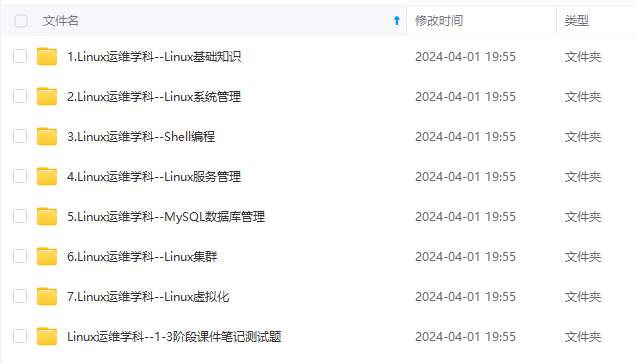k8s搭建gluster集群以及安装nfs-ganesha
1、使用daemon-set的方式进行部署,注意数据目录根据环境自行更改,这里是在每个服务器上创建一个目录/data/glusterfs做为glusterfs的实际存储目录。2、这里是使用主机模式进行部署的,可以在服务器上检查24007端口是否正常启动,服务正常启动后,进入到容器中向集群中添加节点。创建卷,我这里服务器上没有额外的数据盘,就使用了一个/data目录进行创建,生产环境中建议挂载数据盘
·
一、部署gluster集群
1、使用daemon-set的方式进行部署,注意数据目录根据环境自行更改,这里是在每个服务器上创建一个目录/data/glusterfs做为glusterfs的实际存储目录
# glusterfs
---
apiVersion: apps/v1
kind: DaemonSet
metadata:
name: glusterfs
labels:
glusterfs: daemonset
annotations:
description: GlusterFS DaemonSet
tags: glusterfs
spec:
template:
metadata:
name: glusterfs
labels:
glusterfs-node: pod
spec:
nodeSelector:
storagenode: glusterfs
hostNetwork: true
containers:
- image: gluster/gluster-centos:latest
name: glusterfs
volumeMounts:
#数据目录挂载点
- name: glusterfs-data
mountPath: "/data"
- name: glusterfs-heketi
mountPath: "/var/lib/heketi"
- name: glusterfs-run
mountPath: "/run"
- name: glusterfs-lvm
mountPath: "/run/lvm"
- name: glusterfs-etc
mountPath: "/etc/glusterfs"
- name: glusterfs-logs
mountPath: "/var/log/glusterfs"
- name: glusterfs-config
mountPath: "/var/lib/glusterd"
- name: glusterfs-dev
mountPath: "/dev"
- name: glusterfs-misc
mountPath: "/var/lib/misc/glusterfsd"
- name: glusterfs-cgroup
mountPath: "/sys/fs/cgroup"
readOnly: true
- name: glusterfs-ssl
mountPath: "/etc/ssl"
readOnly: true
securityContext:
capabilities: {}
privileged: true
readinessProbe:
timeoutSeconds: 3
initialDelaySeconds: 60
exec:
command:
- "/bin/bash"
- "-c"
- systemctl status glusterd.service
livenessProbe:
timeoutSeconds: 3
initialDelaySeconds: 60
exec:
command:
- "/bin/bash"
- "-c"
- systemctl status glusterd.service
volumes:
- name: glusterfs-heketi
hostPath:
path: "/var/lib/heketi"
- name: glusterfs-run
- name: glusterfs-lvm
hostPath:
path: "/run/lvm"
- name: glusterfs-etc
hostPath:
path: "/etc/glusterfs"
- name: glusterfs-logs
hostPath:
path: "/var/log/glusterfs"
- name: glusterfs-config
hostPath:
path: "/var/lib/glusterd"
- name: glusterfs-dev
hostPath:
path: "/dev"
- name: glusterfs-misc
hostPath:
path: "/var/lib/misc/glusterfsd"
- name: glusterfs-cgroup
hostPath:
path: "/sys/fs/cgroup"
- name: glusterfs-ssl
hostPath:
path: "/etc/ssl"
#这是服务器上的目录,可自行修改
- name: glusterfs-data
hostPath:
path: "/data/glusterfs"
2、这里是使用主机模式进行部署的,可以在服务器上检查24007端口是否正常启动,服务正常启动后,进入到容器中向集群中添加节点
有几个节点就添加几个节点
gluster peer probe 1.2.3.4
peer probe: success查看状态
gluster peer status创建卷,我这里服务器上没有额外的数据盘,就使用了一个/data目录进行创建,生产环境中建议挂载数据盘。
分布式复制模式(组合型), 最少需要4台服务器才能创建。最后边有一个force参数,不加会报错
gluster volume create data-volume replica 2 10.102.23.41:/data 10.102.23.44:/data 10.102.23.42:/data 10.102.23.43:/data 10.102.23.44:/data 10.102.23.4:/data 10.102.23.45:/data 10.102.23.46:/data force
启动创建的卷
gluster volume start data-volume查看创建的卷
gluster volume info查看分布式卷的状态
gluster volume status3、nfs-ganesha环境搭建
yum -y install centos-release-gluster6
yum -y install nfs-ganesha nfs-ganesha-gluster
[root@admin-node ~]# vim /etc/ganesha/ganesha.conf
.....................................
EXPORT
{
## Export Id (mandatory, each EXPORT must have a unique Export_Id)
#Export_Id = 12345;
Export_Id = 10;
## Exported path (mandatory)
#Path = /nonexistant;
Path = /data01;
## Pseudo Path (required for NFSv4 or if mount_path_pseudo = true)
#Pseudo = /nonexistant;
Pseudo = /data01; #客户端通过nfs挂载的根目录
## Restrict the protocols that may use this export. This cannot allow
## access that is denied in NFS_CORE_PARAM.
#Protocols = 3,4;
Protocols = 4; #客户端nfs挂载的版本
## Access type for clients. Default is None, so some access must be
## given. It can be here, in the EXPORT_DEFAULTS, or in a CLIENT block
#Access_Type = RW;
Access_Type = RW; #权限问题
## Whether to squash various users.
#Squash = root_squash;
Squash = No_root_squash; #root降级
## Allowed security types for this export
#Sectype = sys,krb5,krb5i,krb5p;
Sectype = sys; #类型
## Exporting FSAL
#FSAL {
#Name = VFS;
#}
FSAL {
Name = GLUSTER;
hostname = "10.102.23.44"; #glusterfs管理节点IP
volume = "data-volume"; #glusterfs卷名
}
}
...................
[root@admin-node ~]# systemctl restart nfs-ganesha
[root@admin-node ~]# systemctl enable nfs-ganesha
[root@admin-node ~]# showmount -e 10.102.23.44
Export list for 10.102.23.44: #nfs-ganesha搭建成功
4、客户端挂载
以glusterfs方式挂载:
mkdir /logs
mount -t glusterfs 10.102.23.44:data-volume /logs以NFS方式进行挂载
yum -y install nfs-utils rpcbind
systemctl start rpcbind
systemctl enable rpcbind
mkdir /home/dwweiyinwen/logs/
mount -t nfs -o vers=4,proto=tcp,port=2049 10.102.23.44:/data01 /home/dwweiyinwen/logs/更多推荐
 已为社区贡献3条内容
已为社区贡献3条内容









所有评论(0)